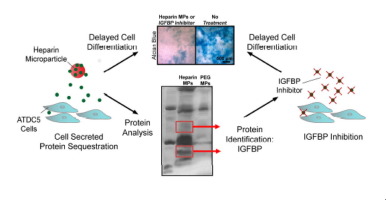Acta Biomaterialia ( IF 9.7 ) Pub Date : 2017-12-30 , DOI: 10.1016/j.actbio.2017.12.038 Torri E. Rinker , Brandon D. Philbrick , Marian H. Hettiaratchi , David M. Smalley , Todd C. McDevitt , Johnna S. Temenoff

|
Protein delivery is often used in tissue engineering applications to control differentiation processes, but is limited by protein instability and cost. An alternative approach is to control the cellular microenvironment through biomaterial-mediated sequestration of cell-secreted proteins important to differentiation. Thus, we utilized heparin-based microparticles to modulate cellular differentiation via protein sequestration in an in vitro model system of endochondral ossification. Heparin and poly(ethylene-glycol) (PEG; a low-binding material control)-based microparticles were incorporated into ATDC5 cell spheroids or incubated with ATDC5 cells in transwell culture. Reduced differentiation was observed in the heparin microparticle group as compared to PEG and no microparticle-containing groups. To determine if observed changes were due to sequestration of cell-secreted protein, the proteins sequestered by heparin microparticles were analyzed using SDS-PAGE and mass spectrometry. It was found that heparin microparticles bound insulin-like growth factor binding proteins (IGFBP)-3 and 5. When incubated with a small-molecule inhibitor of IGFBPs, NBI 31772, a similar delay in differentiation of ATDC5 cells was observed. These results indicate that heparin microparticles modulated chondrocytic differentiation in this system via sequestration of cell-secreted protein, a technique that could be beneficial in the future as a means to control cellular differentiation processes.
Statement of Significance
In this work, we present a proof-of-principle set of experiments in which heparin-based microparticles are shown to modulate cellular differentiation through binding of cell-secreted protein. Unlike existing systems that rely on expensive protein with limited half-lives to elicit changes in cellular behavior, this technique focuses on temporal modulation of cell-generated proteins. This technique also provides a biomaterials-based method that can be used to further identify sequestered proteins of interest. Thus, this work indicates that glycosaminoglycan-based biomaterial approaches could be used as substitutes or additions to traditional methods for modulating and identifying the cell-secreted proteins involved in directing cellular behavior.
中文翻译:

微粒介导的细胞分泌蛋白螯合以调节软骨细胞分化。
蛋白质递送通常用于组织工程应用中以控制分化过程,但受到蛋白质不稳定性和成本的限制。一种替代方法是通过生物材料介导的对分泌重要的细胞分泌蛋白的隔离来控制细胞微环境。因此,我们利用基于肝素的微粒在体外通过蛋白质螯合来调节细胞分化软骨内骨化的模型系统。将基于肝素和聚乙二醇(PEG;低结合性物质对照)的微粒掺入ATDC5细胞球体中,或与ATDC5细胞一起进行跨孔培养。与PEG相比,在肝素微粒组中观察到分化减少,并且不含微粒的组。为了确定观察到的变化是否归因于细胞分泌的蛋白质的隔离,使用SDS-PAGE和质谱分析了肝素微粒隔离的蛋白质。发现肝素微粒结合胰岛素样生长因子结合蛋白(IGFBP)-3和5。当与IGFBP的小分子抑制剂NBI 31772孵育时,观察到ATDC5细胞分化的相似延迟。
重要声明
在这项工作中,我们提出了一组实验证明,其中显示了基于肝素的微粒通过结合细胞分泌的蛋白质来调节细胞分化。与依赖于半衰期有限的昂贵蛋白质来引起细胞行为改变的现有系统不同,该技术着眼于细胞生成蛋白质的时间调控。该技术还提供了一种基于生物材料的方法,可用于进一步鉴定目标螯合蛋白。因此,这项工作表明基于糖胺聚糖的生物材料方法可以用作传统方法的替代或补充,以调节和鉴定参与指导细胞行为的细胞分泌蛋白。



























 京公网安备 11010802027423号
京公网安备 11010802027423号